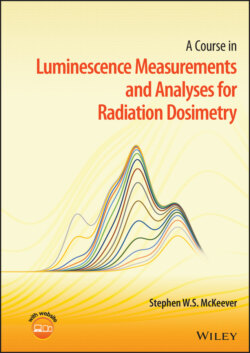Читать книгу A Course in Luminescence Measurements and Analyses for Radiation Dosimetry - Stephen W. S. McKeever - Страница 21
1.3 Brief Overview of Modern Applications in Radiation Dosimetry
ОглавлениеThere are thousands of published articles in the modern scientific literature demonstrating the application of TL, OSL, and RPL in the field of radiation dosimetry. A review of such applications is not the intent here. Instead, the purpose of this section is to give the reader a flavor of the types of use to which these techniques have been put in the general field of the radiation dosimetry. In this sense, we may broadly consider the following areas where radiation dosimetry using luminescence has been shown to be an essential and/or highly useful tool. The areas include:
Personal dosimetry (detection and measurement of dose absorbed by people);
Medical dosimetry (measurement of doses delivered to patients during medical treatments – diagnosis and therapy – to check and confirm the doses delivered);
Space dosimetry (measurement of doses to astronauts and to space vehicles while in orbit or during interplanetary travel);
Retrospective dosimetry (estimation of doses to people in the aftermath of radiation accidents, whether they are small accidents involving a handful of people, or large-scale events involving hundreds or thousands of people; also luminescence dating of geomorphological structures or archaeological artefacts);
Environmental dosimetry (measurement of doses delivered to the environment – air, soil, built structures, and others).
There are other applications (e.g., detection of fake art objects) but those listed above are the main areas in which luminescence dosimetry has found important, not to say vital, application. One of the remarkable aspects of using luminescence in dosimetry is the fact that the phenomenon can be used to detect radiation levels as low as the naturally occurring environmental background levels on Earth, or as high as the radiation levels used in food irradiation or industrial processing, and everywhere in between. When expressed in units of Gray (Gy, where 1 Gy = 1 Joule of energy absorbed by one kilogram of a substance), doses ranging from μ Gy, for environmental radiation, to MGy, for industrial processes can be measured. This represents an amazing 12-orders of magnitude spread. While humans cannot survive in high radiation environments, homo sapiens evolved within a background of environmental radiation here on Earth. Humans can also survive for lengthy periods in more harsh radiation environments such as Space, where doses as high as several tens of mGy might be absorbed, depending on the mission. Much higher doses may be experienced by patients who may be treated with localized radiation doses of several kGy during medical radiotherapy. It is remarkable that luminescence dosimetry has found application in all of these areas.
In what follows, dosimetry applications are further discussed, albeit briefly, in order to give the reader a taste of some important examples.
